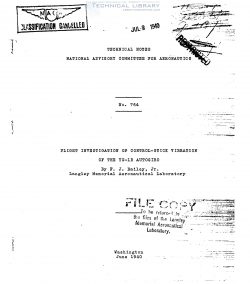naca-tn-764
- Version
- 141 Downloads
- 731.63 KB File Size
- 1 File Count
- November 30, 2016 Create Date
- November 30, 2016 Last Updated
National Advisory Committee for Aeronautics, Technical Notes - Flight Investigation of Control Stick Vibration of the YG-1B Autogiro

As a preliminary step in an investigation of control—
stick vibration in direct— control autogiros, the periodic _
variations in the moments transmitted through the control
system of a YG~lB autogiro were recorded in flight. The
results of the measurements are presented in the form of
coefficients of Fourier series expressing the varying part
of the lateral and the longitudinal moments acting between
rotor and fus.elage at the control trunnions.
The most "important conpone’nt of the variation in
stick force was found to have a frequency of three times
the rotor speed andfan amplitude that rose from negligible_n_
values at tip-speed ratios below 0.20 to $5. 2 pounds lon—
gitudinally and $3.2 pounds laterally at tip-speed ratios
of O. 35. Variations in stick force at all other frequen-
cies were small in comparison with. those at three times
the rotor speed.
Conventional three-blade directdcontrol autogiros of
the tilting-hub type are generally regarded as unsuitable_
for extended cross-country flights, largely because of the
severe vibration of the control stick that appears at air
speeds above 80 miles per hour. The'importance of the
problem of stick vibration has been recognized by design-'
ers and several solutions have been proposed; Because the
relative importance of the various elements of the control
arrangement. asrregards their contribution to stick vibra—
tion, has-never been established, the tendency has been
, to devise an arrangement of the hub and the blades that
will exclude all possibility-of disturbing forces capable
of causing stick vibrations Consequently, all the solu—
tione proposed have invplved'radical departures from con—
ventional arrangements and their development has been slow.
As yet, no entirely satisfactory solution has evolved.
{The fundamental cause of stick vibration is a peri—
odic variation in the moment acting between the rotor and
the fuselage at the lateral- control and the longitudinal-
control trunnionsh From time to time, attempts have been
made to express theoretically the variation in moment and
to determine the modifications required to eliminate the
disturbance. Such attempts have shown some promise but
have always been handicapped by lack of specific experi-
mental data against which the calculations could be checked
to establish the validity_ of the assumptions on _which they
are nec.essarily based.
| File | Action |
|---|---|
| naca-tn-764 Flight Investigation of Control Stick Vibration of the YG-1B Autogiro.pdf | Download |

Comment On This Post